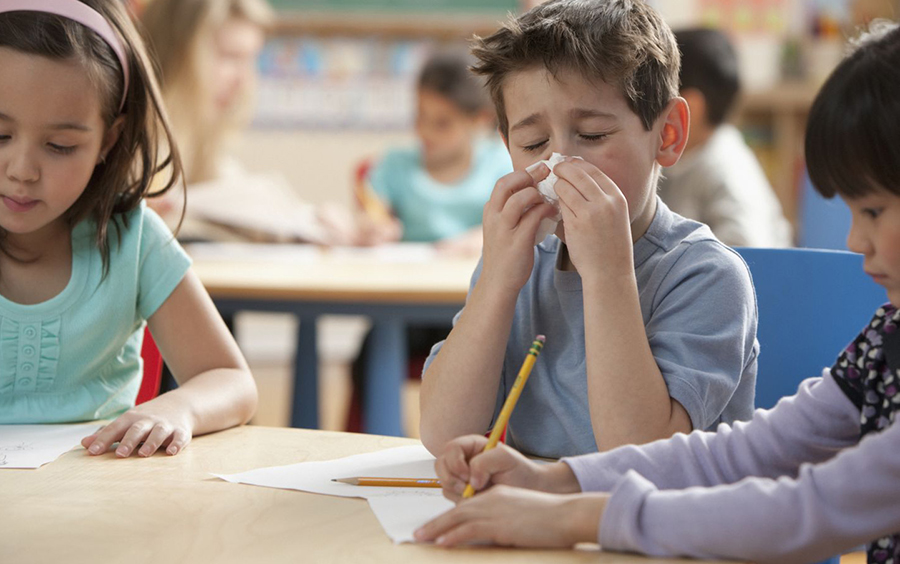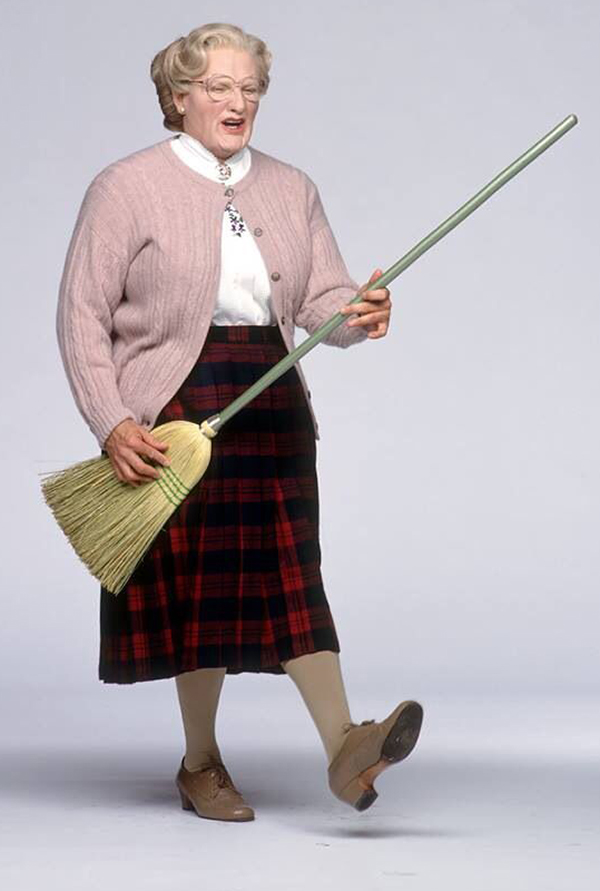Parenting: Frequent Illnesses – related to number of past and present exposures
“Frequent Illnesses in children”
Kids get sick – a lot – and those times when it feels as if your son or daughter are perpetually ill can be not only frustrating but worrisome.
Frequent Illnesses
Related to exposures, Past and Present
by Gregory A. Barrett, M.D.
There are three common situations when these “sicker periods” predictably occur: the addition of a new sibling, the second winter, and entering childcare. Day-care, a reality of modern life, presents a particular dilemma for most parents. There just never seems to be an ideal situation. All options have their pluses and minuses, with one of the biggest negatives being the frequency of illnesses one encounters. However, as we’ll be discussing later, that may not be all bad.
New Sibling
Each subsequent child in the birth order gets sick more often and starts at an earlier age. It stands to reason that when you have those vectors, masquerading as older brothers and sisters, returning home from their adventures in the outside world and spreading germs all over the little one, they’ll get sick. With each new addition to the family, it becomes progressively more difficult to protect your youngest, and frequent illnesses typically ensue as a consequence. “Why does Jerome get sick so much more often than his older sister?” is a very common refrain. The answer is; he has an older sister.
Second Winter

Next is an underestimated factor I have dubbed: The Curse of the Second Winter.
Passive antibody transfer takes place via the placenta from the mother to her unborn child, supplying the newborn with protection against all of the diseases the mother has had in her lifetime… right up until the moment the umbilical cord was clamped. This helpful process is very effective in preventing illnesses for the first nine to twelve months of life.
For example, assuming the mother has a history of chicken pox and her baby is exposed to the disease, there are two likely possibilities: one, the infant will not become infected at all because the antibodies they received from mom are equivalent to natural immunity from actually having had the disease; or two, blunted by the protective maternal antibodies the illness will range from extremely mild to completely undetectable. Most adults who swear they have never had chicken pox actually have, they just had it in the first year of life when it was clinically unrecognizable.
However, by the time of the first birthday the baby is completely on its own immunologically and must begin developing its own antibody responses. The child has vulnerable to any passing virus. So, after a relatively healthy and uneventful first year of life, things are about to get a whole lot busier.
Childcare

The third factor in an anticipated increase in the frequency of sickness is, of course, childcare: either babysitters or daycare. The ideal would be to find a professional sitter who comes to your house each day and takes care of only your child. In addition, it would be preferable if she never gets sick, volunteers to work for virtually nothing because she finds your child to be SO special and adorable… and has a British accent. Well, let me wish you good luck in your search, because locating a nanny such as this is a mighty tall order. And if you do happen to find such a person, she will likely be prohibitively expensive.
Babysitter
Assuming Ms. Poppins is otherwise engaged at the moment, or even if available she charges more than the two of you combined are currently earning, the other option in the private sitter category is to locate someone who does childcare in their home. These setups typically come in two varieties, the stay-at-home mom who is watching her own children anyway and wishes to supplement her income, or the older, grandmotherly type who has time on her hands and simply enjoys the company of little ones.

The advantage of this arrangement is that there is a single maternal figure who will substitute for the absent parent and can be counted on to deliver a more personalized type of care than would otherwise be available. However, sometimes the care can be a little TOO personalized. When you commit to this setting you are submitting yourself and your child to the idiosyncrasies of the caretaker, and believe me, they can be fairly quirky.
In addition, there is the ever-present threat of the home sitter informing you by phone on the morning of THE SINGLE MOST IMPORTANT DAY IN YOUR ENTIRE PROFESSIONAL LIFE that she might be coming down with a migraine or has to catch a bus to Des Moines because her second cousin thrice removed is having emergency gall bladder surgery, or some other such pseudo-crisis, and therefore she is regrettably unable to watch your child today. Believe me, it will happen.
In-Home Sitter
We never really had a whole lot of luck with babysitters. Rachel, my first-born daughter, was only a little over three months old before we finally worked up the nerve to leave her with someone. (By the time our second came around we bailed on about the sixth day, but that’s an entirely different story….)
Her mother had carefully researched the subject with the help of the local middle school counselor friend of hers and had been given the name of an eighth grader who had the highest recommendations for being responsible. I picked up our first sitter at the appointed time, a cute, blonde, thirteen-year-old cheerleader straight out of central casting. She seemed somewhat shy, as one would have expected given her age, but quite nice.
I found myself eagerly looking forward to finally having a meal prepared and served by someone other than myself. We managed to do pretty well during our dinner at the local Ponderosa, only calling home three times for updates in the hour and a half we were gone. Upon our return the babysitter confidently reassured us that our Rachel was upstairs sleeping in her bedroom, and everything was fine.

My new little friend seemed quite a bit more chatty and sociable in the car on the way home (for reasons I was soon to discover), and I felt a sense of elated liberation as I gazed forward to the resumption of a social life in the immediate future.
“Well, that went great, didn’t it?” I smiled, whistling merrily as I dumped my keys on the front table after returning to our apartment.
My wife gave me a strange look.
“Hey, is something wrong?” I inquired.
“Come with me,” she said, her voice shaky.
I followed, and when I arrived upstairs I was completely unprepared for what awaited me. In the bathroom all of her perfume bottles were opened and scattered around the counter, makeup and eyeliner cases were lying on the bed, and the wastebasket was filled with used Kleenex of varying smears of color.
“Uhh, gee, what happened here?” I wondered.
“Oh, that’s not all,” she said coldly. “There’s more.”
In the kitchen she opened the refrigerator and pointed. “See anything missing?”
“Huh-uh,” I replied, searching the typically barren contents. “It looks like everything is here. Say, what happened to the wine I started the other night?”
My wife directed me to the trash can and pointed at the now-empty bottle.
“Huh?”
Then she led me to the sink and THREE used wine glasses.
Uh-oh. Goldilocks had been busy. So much for my social life. Putting it mildly, the experience was scarring. As a consequence, Rachel was scarcely out of our sight for much of the following year.
Commercial Daycare

The alternative to a home baby-sitting arrangement for working parents is, of course, the commercial day-care. The type of care your child receives in this setting is, by comparison to the home setting, rather impersonal and generic; although that is not necessarily a negative. They have stated hours upon which one can depend, and on those days come rain, sleet, snow, migraine headache, or the passing of a distant relative in Iowa, they will be open. The reliability factor lowers one’s stress level immeasurably. However, by gosh you’d better be there to pick up your child by six o’clock or else! This lack of flexibility can, and will, create problems.
The biggest issue for parents with day-care is that with increased exposures our sons and children will get sick a whole lot more often. Compounding this is that in spite of the undeniable fact your kid caught the darned virus at the daycare he or she will be banned from returning to the scene of the crime until the pink eye has been treated, the stools are no longer loose, or the temperature has been normal for twenty-four hours. And that is a policy, although not unreasonable, which can drive you just plain nuts.
When you sign on for day-care you must accept the fact that your child is entering into a veritable garden of viruses. Frequency of illness is proportional to the number of exposures, so you may as well steel yourself in advance to the eventuality that your child is going to get sick a lot more often. The people at the daycare will do their best via their protocols to keep exposures to a minimum, but there are so many illnesses in which contagiousness actually precedes the recognizable appearance of symptoms that this is by and large a relatively impossible task.

One unintentionally humorous study I recall which addressed this issue a number of years ago (and printed in a highly reputable medical journal, by the way) compared the “common cloth technique” described as one rag being used per day to wipe all the runny noses of all the children in a daycare room versus individual wipes for each child. Not surprisingly the number of respiratory infections were significantly higher in the establishments which used the common cloth and the authors with considerable gravity concluded that this practice should be discouraged. The amazing part of this report is that anyone felt such a gross practice even needed to be studied in the first place.
Another recent and more germane article simply compared school attendance in kindergarten and first grade between children kept at home with those who spent their early years in a daycare environment, and to no one’s surprise the day-care kids faired worlds better. This introduces an extremely critical concept which has virtually revolutionized our thinking about nearly everything in the world of pediatrics known as:
THE HYGIENE HYPOTHESIS
According to legend, the initial report came from Israel decades ago when researchers postulated that there might be a connection between lack of exposure to dust particles early in life and the later development of multiple sclerosis. No one paid much attention to it at the time, but over the years physicians occasionally wondered why one never (or a least rarely) saw a farm kid with asthma. Later studies followed which established that children who came from rural areas, larger families, and a non-sterile environment were less likely to develop hay fever or eczema than peers raised in the suburbs, smaller families, or more hygienically pristine households. These findings have been expanded to include an association with a broad range of chronic inflammatory and autoimmune diseases. And the benefits of exposure have been proven to include viruses and bacteria every bit as much as dust or mold.
Pets

Exposure to pets is a simple, straightforward application of the Hygiene Hypothesis. Think about it – if you don’t want your child to be allergic to a dog, what should you do? The answer? Have a dog in your house when you bring your baby home from the delivery room. Don’t wait until your son or daughter is a teen to introduce them to Rover.
The field of nutrition has been especially affected by this new philosophy. It is a fact that the incidence of food allergies has been increasing rapidly in America. The medical establishment’s response to this phenomenon was to recommend that certain foods – including eggs, nuts, citrus, and strawberries, among others – be deferred until the child was older, at which time he or she would presumably tolerate them much better. Now, in retrospect, that never made a lot of sense in the first place, and there was never much in the way of scientific backing for this approach, but for years these instructions became the gospel in pediatric nutritional counseling.
It took our friends in Europe to finally challenge this cherished theory. The researchers took two groups of children and separated them into those who were given peanut products starting at an early age (4-6 months) versus controls who had no exposure until around two years, and the results were stunning. The early introduction kids had no problem with peanuts whatsoever, whereas those who were deprived of Peter Pan until later had a high incidence of allergic (including anaphylactic) reactions.
“Oops,” replied the American pediatric establishment, “I guess we had it wrong.” And this makes sense in the context of the Hygiene Hypothesis. Early introduction, the immune system recognizes the food as normal; defer until later and it appears foreign leading to a deleterious, allergic, autoimmune reaction in the body. Thus, the current recommendation for an earlier, more aggressive introduction of a robust variety of foods. And our children are healthier and heartier as a result.
Being raised in a somewhat dusty environment with frequent exposures to viruses, animal dander, and a varied diet is actually advantageous in that it stimulates and strengthens the immune system. Sparing the vacuum cleaner a tad might just lead to spoiling the later development of allergies and asthma among a myriad of other conditions.
A typical healthy child will contract six to eight viral illnesses per year, usually consisting of colds, flus, gastroenteritis, and the like. More often than not, when enduring a particularly bad spell, your son of daughter is still basically healthy. They’re simply going through…
ONE-THING-AFTER-ANOTHER SYNDROME
Take reasonable, practical precautions, and don’t go looking for trouble, but at the end of the day accept the reality that they are going to take their lumps. That’s just how life is, so be philosophical. Sooner or later children are going to catch pretty much everything there is out there to catch. Maintain a proper perspective during these times and try to keep your focus on the bigger picture.
Remember the Hygiene Hypothesis. A stronger immune system, fewer allergies, improved school attendance, and better long-term health can come from not having your child living in a plastic bubble.
☤


